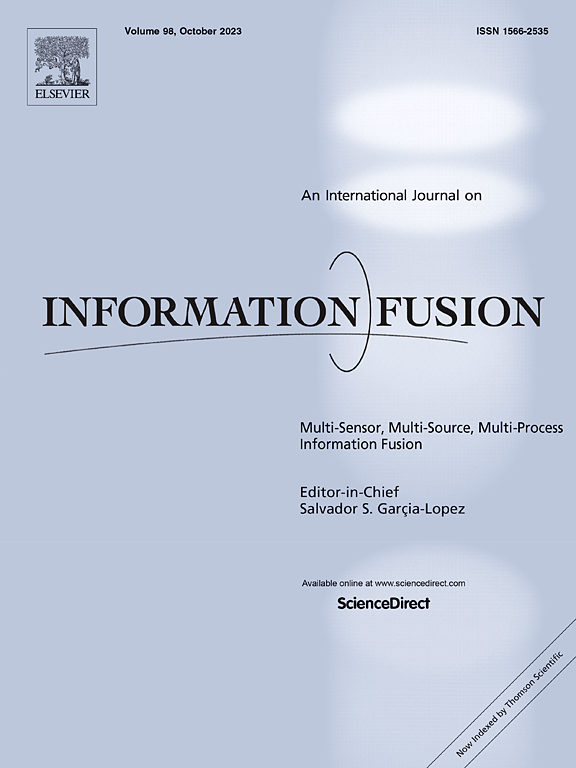An interpretable integration fusion time-frequency prototype contrastive learning for machine fault diagnosis with limited labeled samples
IF 14.7
1区 计算机科学
Q1 COMPUTER SCIENCE, ARTIFICIAL INTELLIGENCE
引用次数: 0
Abstract
The rise of Industry 4.0 and Industry 5.0, focusing on digital transformation and human-machine collaboration, has boosted the need for advanced fault diagnosis technologies. These must be interpretable to ensure industrial efficiency, reliability, and safety. However, current methods often rely on single-sensor information, require many labeled samples for training, and struggle to justify diagnostic decisions. These limitations reduce their effectiveness in real-world production environments. Aiming at these problems, this paper proposed an interpretable integration fusion time-frequency prototype contrastive learning (IIF-TFPCL) for machine fault diagnosis with limited labeled samples. First, a data-level fusion method based on integrated Gini coefficient entropy is designed to achieve credible fusion of multi-sensor signals while enhancing the fault characteristics of the fused signals. Second, an interpretable wavelet feature fusion convolutional transformer architecture is constructed to achieve interpretable fault extraction from faulty signals. Then, a dual dynamic pseudo-labeling selection strategy is devised to efficiently choose high-confidence unlabeled samples from the original imbalanced unlabeled data. In this process, a self-attention mechanism is employed to measure the correlation between unlabeled samples and initial prototypes. Finally, a time-frequency prototype contrastive loss is constructed to enhance the discriminative ability and robustness of the network in fault diagnosis tasks. The IIF-TFPCL was validated using fused multi-sensor signals and various original single-sensor signals. The experiments display that it is significantly superior to the remaining seven comparison methods. The experimental analysis demonstrates the excellent fault identification performance and interpretability of the IIF-TFPCL with limited labeled data.
基于可解释积分融合时频原型对比学习的有限标记样本机器故障诊断
工业4.0和工业5.0的兴起,聚焦于数字化转型和人机协作,促进了对先进故障诊断技术的需求。这些必须是可解释的,以确保工业效率,可靠性和安全性。然而,目前的方法通常依赖于单一传感器信息,需要许多标记样本进行训练,并且难以证明诊断决策的合理性。这些限制降低了它们在实际生产环境中的有效性。针对这些问题,本文提出了一种可解释积分融合时频原型对比学习方法(IIF-TFPCL),用于有限标记样本的机器故障诊断。首先,设计了一种基于集成基尼系数熵的数据级融合方法,实现多传感器信号的可信融合,同时增强融合信号的故障特征;其次,构造可解释小波特征融合卷积变压器结构,实现故障信号的可解释故障提取;然后,设计了一种双动态伪标记选择策略,从原始不平衡未标记数据中高效地选择高置信度的未标记样本。在此过程中,采用自注意机制来衡量未标记样本与初始原型之间的相关性。最后,构造了时频原型对比损失,增强了网络在故障诊断任务中的判别能力和鲁棒性。IIF-TFPCL使用融合的多传感器信号和各种原始单传感器信号进行验证。实验结果表明,该方法明显优于其他7种比较方法。实验分析表明,在有限标记数据下,IIF-TFPCL具有良好的故障识别性能和可解释性。
本文章由计算机程序翻译,如有差异,请以英文原文为准。
求助全文
约1分钟内获得全文
求助全文
来源期刊

Information Fusion
工程技术-计算机:理论方法
CiteScore
33.20
自引率
4.30%
发文量
161
审稿时长
7.9 months
期刊介绍:
Information Fusion serves as a central platform for showcasing advancements in multi-sensor, multi-source, multi-process information fusion, fostering collaboration among diverse disciplines driving its progress. It is the leading outlet for sharing research and development in this field, focusing on architectures, algorithms, and applications. Papers dealing with fundamental theoretical analyses as well as those demonstrating their application to real-world problems will be welcome.
 求助内容:
求助内容: 应助结果提醒方式:
应助结果提醒方式:


